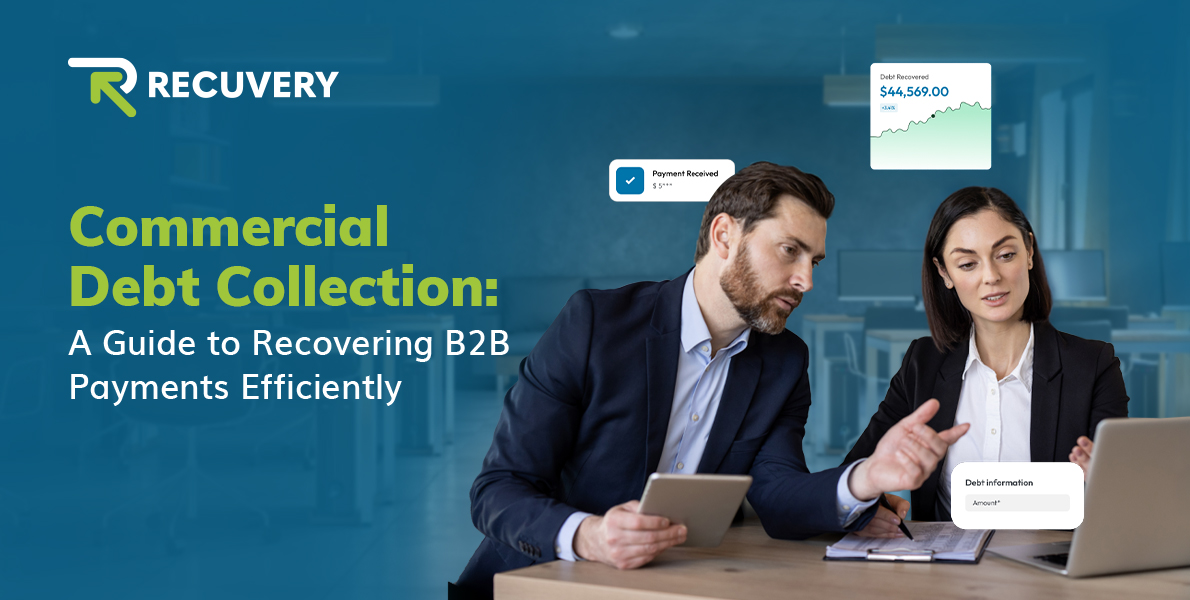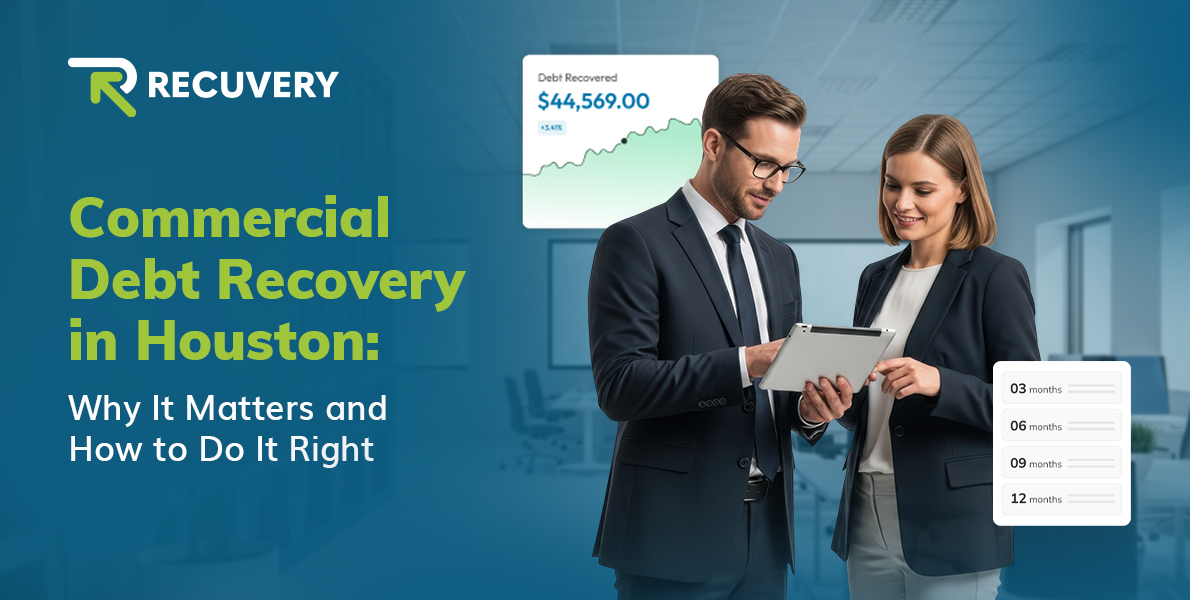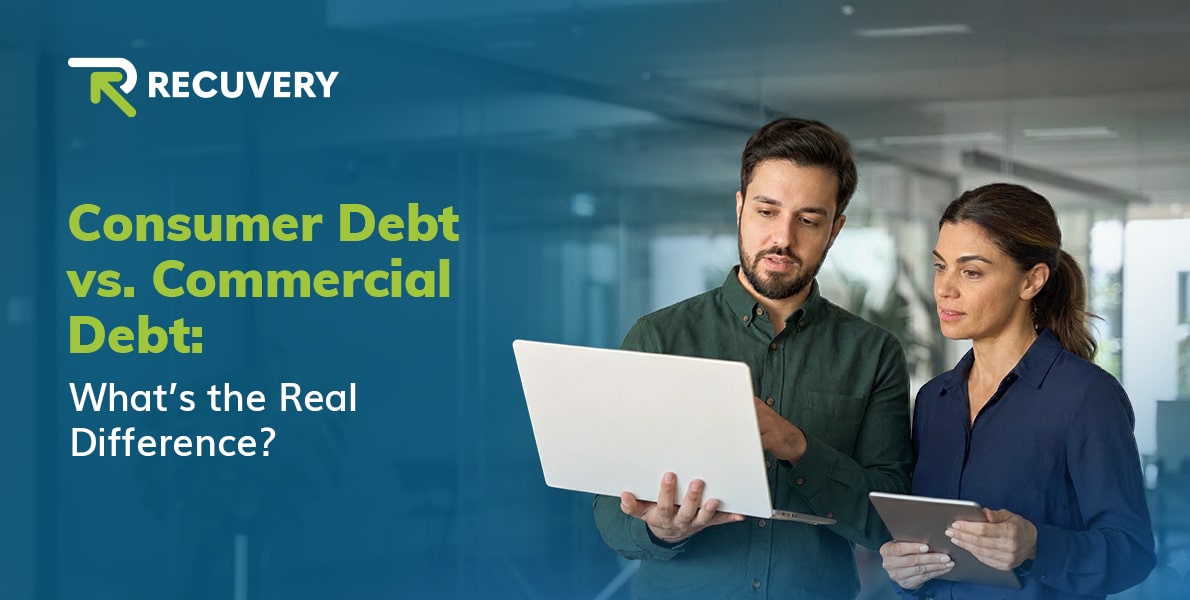Commercial Debt Collection: A Guide To Recovering B2B Payments Efficiently

A few months ago, a small marketing agency wrapped up a major campaign for a client. The results were stellar – high engagement, solid ROI, glowing feedback. The only thing missing? The payment.
Weeks turned into months. Follow-up emails went unanswered. Phone calls were dodged. The agency’s team, already juggling multiple projects, now had to figure out how to collect what they were owed without damaging the client relationship or losing time.
This isn’t just a one-off situation. According to QuickBooks, nearly 73% of businesses are negatively impacted by late invoices. It’s becoming increasingly common in the world of business-to-business (B2B) transactions.
What that agency experienced was commercial debt – money owed by one business to another. And like many companies, they had no real system in place to handle it.
That’s where B2B debt collection comes in. Whether you’re a startup or an established enterprise, having a clear, effective strategy for business debt recovery is no longer optional.
With rising economic uncertainty and tighter cash flow, more businesses are turning to commercial debt recovery solutions, from automation tools to specialized B2B collection agencies, to make sure overdue payments don’t become permanent losses.
In this guide, we’ll unpack what commercial debt collection means, how the process works, and how you can take control of overdue accounts before they slow your growth.
What Is Commercial Debt Collection?
Commercial debt collection is the process of recovering unpaid invoices or outstanding balances that one business owes another. It’s part of doing business, just not the part most people enjoy talking about.
But when a client doesn’t pay on time (or at all), and those overdue invoices start piling up, the impact can be real: delayed projects, cash flow stress, and tough financial decisions. That’s why having a clear strategy for collecting B2B (business-to-business) debt is so important.

Differentiate Between Consumer and Business to Business Debt Collection
While both processes aim to recover money owed, the key difference lies in who owes the debt.
- Consumer debt collection involves individuals, such as missed credit card payments or unpaid utility bills.
- Business to business debt collection involves businesses. It’s one company trying to recover payment from another company, usually for services rendered, goods delivered, or contracts fulfilled.
The stakes are often higher in B2B cases. We’re talking larger sums, longer sales cycles, and ongoing partnerships that you might want to preserve. That’s why commercial debt recovery typically requires a more nuanced and professional approach.
Steps Involved in Collecting Commercial Debt
The process of collecting commercial debt usually unfolds in stages, starting internally and escalating only if necessary:
1. Internal Follow-Ups
A friendly reminder or two. Maybe an email with the invoice attached again. Often, this works, especially if the delay was accidental.
2. Formal Notices
If the payment still hasn’t arrived, it’s time for more official communication. This might include demand letters or notices of intent to escalate.
3. Negotiation or Payment Plans
Sometimes the client is willing but unable to pay in full. This is when flexible payment plans can keep things civil and get you paid.
4. Outsourcing to a B2B Collection Agency
If it’s dragging on or communication has broken down, bringing in a commercial debt collection agency may be the next logical step. These agencies specialize in professional, compliant recovery that aims to preserve the relationship when possible.
Typical B2B Collections Scenarios
A wholesaler delivers a large inventory order to a retailer, but months later, the invoice remains unpaid despite multiple reminders.
A digital agency completes a branding project for a startup. The startup goes quiet after delivery, leaving the agency unpaid and in limbo.
A manufacturer supplies raw materials to a construction company. Payment is promised “next week” again and again… but it never comes.
In all these cases, the creditor isn’t trying to be aggressive. They just want to be paid for work they’ve already done. That’s what commercial debt collection is all about: reclaiming what’s rightfully owed, in a way that’s professional, effective, and respectful.

Discover How Houston Businesses Can Successfully Recover Commercial Debt
Read Our GuideWhy Timely Commercial Debt Recovery Matters
Timely commercial debt recovery is about protecting your business from preventable risks and keeping your growth plans on track. Here’s why it matters more than you might think:
✦ Keep Your Cash Flow Healthy
Receiving payments on time ensures your business runs smoothly, covers bills, pays your team, and minimizes unnecessary stress. If invoices are left unpaid, it can slow you down, even if the work has already been completed. Act early to stay in control and avoid tough choices such as cutting back or dipping into savings.
✦ Aging Debt = Shrinking Chances of Recovery
Once a payment is more than 90 days late, your chances of getting the full amount back drop fast. Late payments can slip through the cracks or become impossible to recover. A solid follow-up plan helps you recover what you’re owed.
✦ Delayed Payments Strain Relationships
It’s never fun to chase payments, especially when the client relationship matters. But waiting too long can make things even more uncomfortable. Reaching out early keeps things professional and clear, helping avoid tension and protect long-term relationships.
✦ Consistent Follow-Ups Show You Mean Business
Following up regularly doesn’t make you aggressive – it shows you’re serious and organized. When clients see that you mean business, they’re more likely to respond quickly and take you seriously.
✦ Fuel Your Growth with Collected Revenue
Unpaid invoices hold back your growth. Every dollar you recover is fuel for your next hire, your next product, or your next expansion. Stay on top of collections, and keep moving your business forward.
In-House Collections vs. Hiring a B2B Collection Agency
Running a business means dealing with late payments at some point — it’s just part of the game. But when invoices go unpaid for too long, the big question is: Do you chase them down yourself, or call in the pros? Let’s break it down.
| Aspect | In-House Business Debt Collection | Hiring a B2B Collection Agency |
| Control | Full control over tone and timing | Less control over client interactions |
| Cost | No third-party fees initially | Commission or recovery fee applies |
| Time & Resources | Time-consuming for the internal team | Saves time – handled by experts |
| Cash Flow Impact | Slower recovery can hurt cash flow | Faster, more efficient collections |
| Client Relationships | Personalized approach preserves rapport | Risk of damaging customer relationships if not managed well |
| Tools & Legal Power | Limited tools and legal leverage | Access to legal recourse and advanced systems |
| Efficiency with Older Debts | Harder to recover the longer it sits | Skilled in recovering aged or complex debts |
| Scalability | Becomes harder as volume grows | Easily scales with business needs |
When to Consider a Commercial Debt Recovery Agency?
Not every late invoice needs to be escalated. But here are signs it might be time to bring in the big guns:
- It’s been 60+ days and there’s no response, no payment, no plan.
- Your in-house team is stretched thin, and collections are falling through the cracks.
- You’re dealing with large, recurring debts that impact your cash flow.
- Clients are ghosting you despite multiple follow-ups.
- You need legal intervention or credit bureau reporting.
How Much Does It Cost to Hire a Collection Agency?
So, you’re thinking about hiring the pros to recover unpaid invoices, smart move. But before you proceed, it’s fair to ask: What’s it going to cost me? The answer: it depends. Collection agencies offer several different pricing models, and the final cost usually depends on factors like how old the debt is, how much is owed, and even where your client is located.
Let’s break it all down!
| Common Collection Agency Fee Structures | ||
| Fee Type | How It Works | What You Should Know |
| Contingency Fee | You only pay if they collect. Usually a percentage of the amount recovered (e.g., 20–50%). | Most common. No recovery = no cost. Great for cash-strapped businesses. |
| Flat Fee | A fixed amount paid upfront or per account, regardless of outcome. | Typically lower cost, but riskier — you pay whether or not they collect. |
| Tiered Rates | The older or harder the debt, the higher the fee. | For example, a 30-day debt might cost 15%, while a 180-day debt could cost 40%. |
| Hourly/Retainer Fees | Rare in B2B — some agencies charge for ongoing legal support or large volume accounts. | More common with high-volume or international collections. |
What Affects the Cost?
Just like with anything else in business, there are a few variables that can change what you end up paying:
➤ Age of the Debt
- Older debts are harder to collect.
- Agencies charge more for debts that are 90+ or 180+ days overdue.
- Pro tip: Don’t wait too long — earlier action = lower fees and higher recovery odds.
➤ Amount Owed
- Some agencies charge a lower percentage for high-value accounts, especially if they’re recent.
- Small balances might cost more proportionally because effort stays the same, but return is lower.
➤ Location of the Debtor
- International or out-of-state recoveries often cost more due to legal complexity and logistics.
- Agencies may work with partners in different regions, which can increase the cost.
➤ Need for Legal Action
- If the case goes to court, expect extra fees for legal filing, attorney time, or court representation.
- Some agencies handle this in-house, others outsource it — costs vary.
Real Talk: What Should You Expect to Pay?
Here’s a general guide:
| Debt Type / Situation | Estimated Fee Range |
| New B2B debt (under 60 days) | 15% – 25% contingency |
| Older debts (90–180+ days) | 30% – 50% contingency |
| Flat fee per account | $15 – $50+ per file (no guarantee) |
| Legal escalations | Additional legal fees may apply (case-by-case) |
What to Look for in a B2B Debt Collection Agency
Selecting a B2B debt collection agency isn’t just about who can be the loudest on the phone — it’s about partnering with someone who protects your reputation while getting results. Here’s what truly matters:
♦ Compliance is Non-Negotiable
You need a partner that plays by the rules — FDCPA, state laws, industry regulations — all of it. Non-compliance can land you in legal trouble or damage your brand. Look for agencies that offer transparent documentation and follow ethical recovery practices.
♦ Professionalism Over Pressure
Aggressive, outdated tactics are a quick way to lose good clients, even the ones who do pay eventually. Choose an agency that uses respectful, firm-but-fair communication that preserves client relationships while still getting the job done.
♦ Proven Recovery Rates
Results matter. Ask about success rates, average recovery time, and their process for different types of debt. An agency worth your trust should offer real performance data and ideally, case studies.
♦ Industry-Specific Experience
Debt recovery isn’t one-size-fits-all. Agencies that understand your niche — whether that’s healthcare, SaaS, construction, or professional services — will know how to navigate contract terms, seasonal cash cycles, and client expectations. That insight leads to smarter outreach and better recovery.
Why Consider Recuvery for Commercial Debt Recovery?
Recuvery is a modern alternative to traditional agencies, built for businesses that want a smarter, scalable, and more brand-aligned way to collect commercial debt.
- Automated, yet empathetic collections that maintain professionalism and customer trust
- Compliance & documentation keep debt collection within legal boundaries with full records of outreach.
- Industry-agnostic automation that adapts to your terms, client type, and invoice volume.
- Real-time tracking of recovery rates, cash flow impact, and performance metrics.
- Flexible repayment plans & self-serve options that let clients choose to pay in full or in instalments, reducing friction and preserving relationships.
- Credit bureau reporting encourages quicker repayment with compliance built in.
- Scalable automation capable of handling thousands of accounts with smart workflows and AI prioritization.
- API integrations that work with your existing CRM/accounting tools.
Whether you’re chasing down dozens of overdue invoices or trying to scale a growing team, Recuvery brings a tech-driven, reputation-safe approach that delivers.
Best Practices for Preventing B2B Debt
Here’s how to stay ahead of the curve:
➮ Know Who You’re Dealing With
Before you lock in any deal, do a quick background check. Look into their credit history, payment behavior, and financial stability, especially for larger or long-term contracts.
➮ Be Clear About How and When You Want to Get Paid
No more vague payment terms. Spell out everything:
- Due dates
- Late fees (if any)
- Accepted payment methods
- Billing contact info
Put it all in writing. Contracts and invoices should leave zero room for confusion.
➮ Automate Invoicing & Reminders
Manual follow-ups fall through the cracks. Automate your invoicing process so clients receive timely reminders before, on, and after due dates. The more consistent and professional your communication, the more likely you are to get paid on time.
➮ Offer Payment Flexibility
Not every client pays late out of bad intent—sometimes it’s just timing. Consider offering:
- Installment plans
- Early payment discounts
- Easy digital payment options
Making payments convenient = better chances of getting paid on time.
➮ Follow Up Promptly and Politely
Don’t wait 30 days to check in. A friendly nudge a few days before and after the due date helps prevent forgetfulness and signals that you’re on top of things.
➮ Document Everything
Always keep records of contracts, emails, follow-ups, and payment agreements. In case things go south, you’ll want a paper trail to support your next move, whether it’s escalation or legal action.
Conclusion
Proactive B2B debt recovery isn’t just about getting paid. It’s about protecting your cash flow, building healthier client relationships, and setting your business up for long-term stability. When you take action early, you avoid the snowball effect of overdue payments and keep your operations running smoothly. Whether it’s tightening your internal processes or using smart tools to stay on top of collections, every step matters. And if things start slipping out of your hands, don’t hesitate to bring in the pros.

FAQs Commercial Debt Recovery
1. What Is B2B Debt Collection?
B2B debt collection is the process of collecting outstanding payments owed by one business to another for services. It involves formal communication, documentation, and sometimes legal escalation to recover outstanding amounts while maintaining a professional relationship with the client.
2. How Do B2B Debt Collections Differ From Consumer Collections?
B2B debt collections typically involve larger amounts, longer payment terms, and more complex contracts compared to consumer collections. The process is more structured and often requires industry-specific knowledge and tactful negotiation.
3. What Does Business-to-Business Collections Usually Involve?
Business-to-business collections include sending reminders, negotiating payment plans, and escalating overdue invoices through internal teams or collection partners. It’s about recovering the money owed while protecting your brand reputation and client relationships.
4. When Should I Consider B2B Debt Recovery Services?
You should consider B2B debt recovery if invoices remain unpaid beyond agreed terms, communication has stalled, or internal follow-ups aren’t working. Early action improves your chances of recovery and keeps your cash flow steady.
5. Why Is Business to Business Debt Recovery Important for My Company?
Business to business debt recovery helps reduce financial risk, prevent write-offs, and support long-term growth. By staying proactive with collections, you maintain better liquidity and avoid unnecessary stress over late payments.






